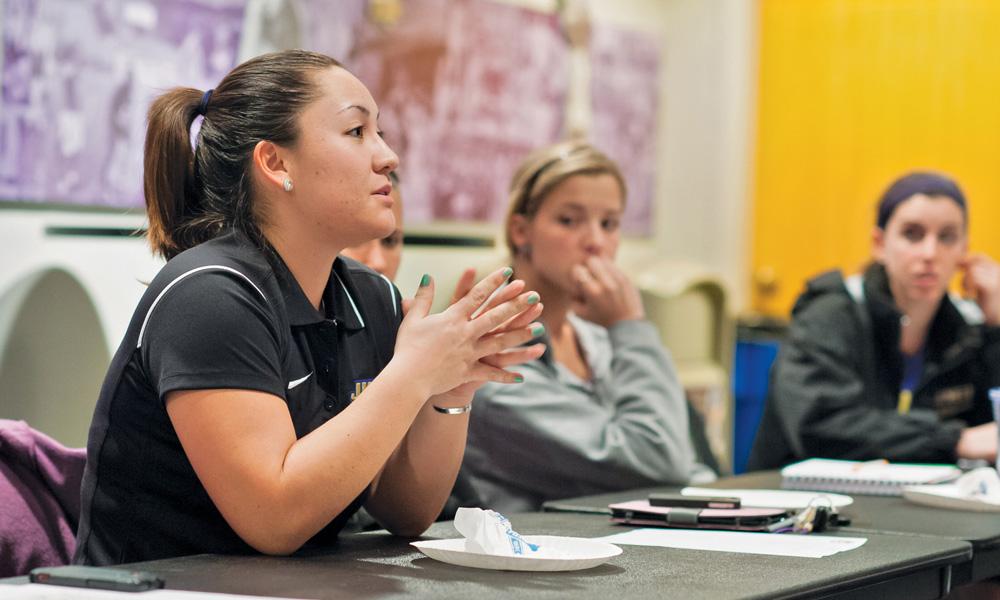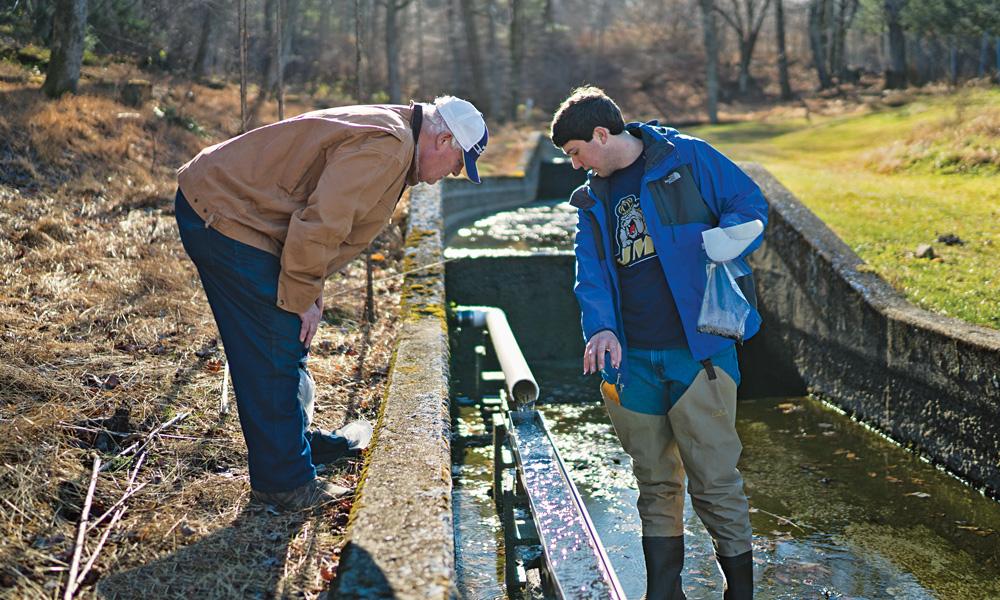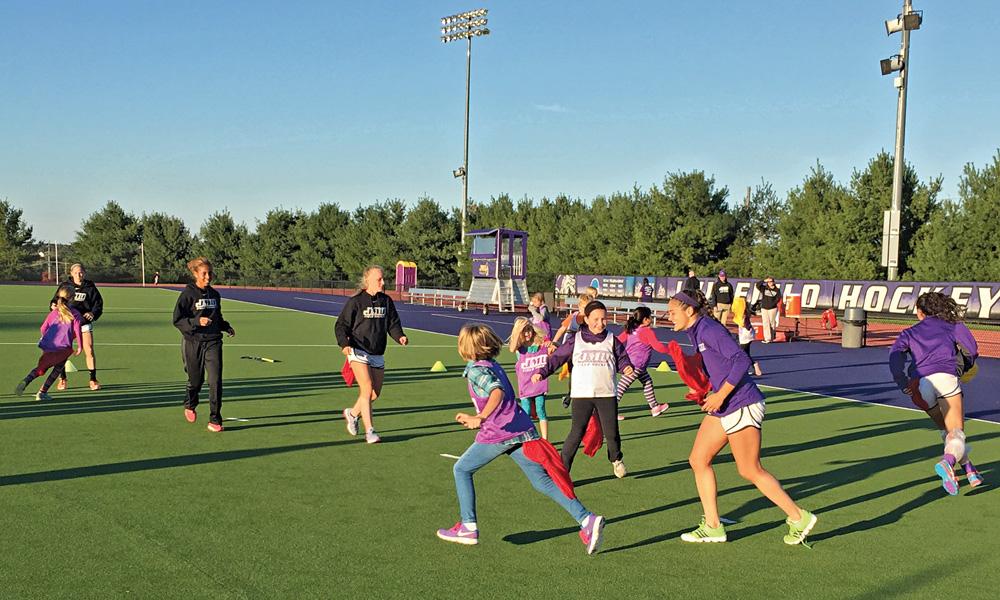A balanced equation
Leveling academic and athletic responsibilities with JMU support
News
SUMMARY: Throughout the university's history, excellent coaches and faculty have worked together to help student-athletes develop their skills and talents, all with a goal of earning a college degree.
from the Spring/Summer 2017 issue of Madison
A collective balance of academics and athletics has long been a hallmark of the student-athlete experience at JMU. From the basketball and tennis clubs of the university’s 1908 founding to today’s championship intercollegiate teams, dedicated student-athletes have represented their school on the field, on the track, in the pool and on the court while concurrently living up to their academic responsibilities.
“Academics and athletics can live in harmony and you can, in fact, be successful at both,” says Director of Athletics Jeff Bourne. “JMU does a wonderful job of combining the pieces.”
The combination is the result of careful attention to equipping student-athletes for success. Throughout the university’s history, excellent coaches and faculty have worked together to help student-athletes develop their skills and talents, all with a goal of earning a college degree. Recalling his 1971 hiring by President Ronald Carrier and Men’s Athletics Director Dean Ehlers, Challace McMillin says, “Their philosophy was to make sure the athletes got a college education so they would be able to meet their goals.”
 |
| A member of the inaugural 1972 football team at Madison, professor Dan Downey’s ('75) career in environmental chemistry has included work with the U.S. Forest Service and Virginia Department of Game and Inland Fisheries. |
McMillin, who was hired to coach track and field, shouldered responsibility for forming the school’s football program in 1972. Following an inaugural season playing junior varsity teams and not scoring a single point, McMillin’s teams quickly improved to a winning varsity season in 1974 and an undefeated season in 1975.
|
'Academics and athletics can live in harmony and you can, in fact, be successful at both.' —Director of Athletics Jeff Bourne |
“We have a very, very narrow number of student-athletes who ever go on to any form of professional sport,” Bourne says. “The vast majority of our students graduate and go into careers. That’s our focus.”
JMU’s 82 percent student-athlete graduation rate is validation of that commitment. “We’re graduating at approximately the same rate as the entire university,” says Roger Soenksen, JMU’s faculty athletic representative. “We’re really proud of that because we’re asking our students to do two full-time jobs.”
For JMU’s approximately 450 student-athletes on 18 intercollegiate teams, the dual role requires time management, self-discipline, dedication, focus and sacrifice of personal time. Campus resources such as the Student Success Center, Career and Academic Planning and meetings with individual faculty members—resources available to all students—are regularly encouraged.
|
'We're graduating at approximately the same rate as the entire university. We're really proud of that because we're asking our students to do two full-time jobs.' —Roger Soenksen, JMU's faculty athletic representative |
Required study sessions, a practice dating to McMillin’s tenure, have evolved into taking advantage of the resources in the Challace McMillin Academic Center, named for the man who describes himself as “a teacher and a coach.” There, inside the Plecker Performance Center, student-athletes have access to a computer lab, tutoring space and meeting areas to focus on their assignments and academic advisers who help them register for classes and provide assistance each semester.
“I feel incredibly supported by JMU student-athlete academic services,” says Rachel Maizel, a freshman psychology major who plays field hockey and is enrolled in the Honors College. Individual faculty members have made a difference, too. “One of my professors met with me at 6:30 p.m. after practice and classes to help me. This really showed me how dedicated the professors are here at JMU to help their students, no matter what circumstances they have.”
 |
| Erica Royal, Melanie Kusakavitch and Rachel Maizel share their love of field hockey through the Purple Pups program, geared toward teaching the fundamentals of the sport to area youth ages 3 to 10. |
If a situation requires more personal assistance, Soenksen, the faculty athletic representative, is prepared to be “a bridge from the athletic community to every academic unit on campus.” Serving in the role since 2006, Soenksen, who holds dual appointment as a professor of media arts and design and communication studies, has occasionally advocated for a student-athlete with a faculty colleague to solve the problem of a test scheduled during team travel, to the point of proctoring tests himself.
JMU’s tradition of valuing and supporting both sides of the student-athlete equation is continuing with today’s men and women.
“I have always been driven on and off the field, but playing at the Division I level has taught me new limits,” says field hockey player Melanie Kusakavitch, an Honors College junior majoring in health sciences and enrolled in the pre-medicine program. “I have learned to be disciplined on the 10-hour bus rides and not just watch Netflix. I have learned how to perform on the field after staying in the library all night. It has not been easy, but it has been the most rewarding experience of my life."
